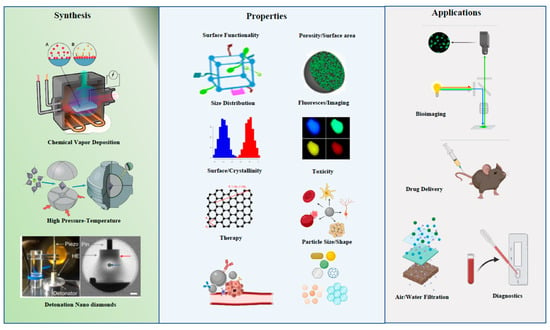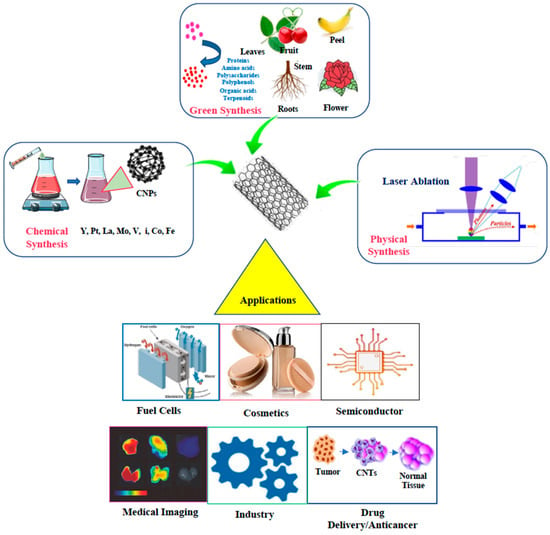You're using an outdated browser. Please upgrade to a modern browser for the best experience.
Please note this is a comparison between Version 1 by Simon Hinkley and Version 2 by Camila Xu.
Carbon nanoparticles (CNPs) have demonstrated utility in a wide range of biological applications such as imaging, sensing and as surface-coatings. Biomass waste can be derived from either plant or animal matter as a result of processing higher-value materials, for instance leaves from trees as by product from processed wood or paper production. Biomass is abundant: trees, agriculture crops, energy crops, fruits, vegetation, wood, aquatic plants and algae, general municipal waste and animal waste.
- green synthesis
- carbon nanomaterials
- biomass
1. Introduction
Carbon nanoparticles (CNPs) have demonstrated utility in a wide range of biological applications such as imaging, sensing and surface-coating. They enjoy a growing range of applications in the drug delivery of a number of biomolecules such as DNA, antibodies, and proteins. CNPs are considered the ideal candidates for metal-based sensor applications and rapid diagnostic assays due, in the main part, to their high fluorescence value. As such, they can displace gold, colored latex, silica, quantum dots, or phosphor nanoparticles, in relevant applications (Figure 1) [1][2][3][4][5][1,2,3,4,5].

Figure 1.
Synthesis, properties and applications of carbon nanoparticles.
CNPs have a range of highly desirable attributes; they exhibit low toxicity, high biocompatibility, can be readily suspended into solution [6] and can be modified post-production with a range of chemical functionality. Carbon based materials already play a critical role in many applications: electro-catalysts, electrodes in storage devices, biofuels, heterogenous catalysis and photo catalysis [7]. Carbonaceous materials form the basis of gas storage (e.g., CO2), hydrogen capture, water purification and as additives to rectify soil properties [2]. The field of optical sensing has been extended with the discovery of highly fluorescent CNPs and carbon nanodots (CNDs) [8][9][8,9]. CNP and CND probes demonstrate remarkable properties; emission characteristics that are tunable based on particle size, high emission quantum yields, physical and chemical stability, narrow spectral bands and optimization of the surface to effect selective sensing applications [10]. Other than optical sensing, these CNPs have also seen use in applications such as photocatalysis, bioimaging and optoelectronics [11][12][13][11,12,13]. A typical example of optical sensing is the light-emitting properties of semiconductor quantum dots (QDs) used for in vitro and in vivo bioimaging [14][15][16][14,15,16] (Figure 2). QD’s strong optical absorption peaks are very sensitive to the surrounding environment and medium, which enables biomolecule calorimetry to be completed [17][18][17,18]. Another significant advantage of CNPs is that they can be produced economically with high purity and are readily fabricated from naturally occurring biomass and generated utilizing green chemistry [19].

Figure 2.
Types of syntheses of CNPs and example applications.
Since the pioneering studies by Sumio Iijima in 1991 with the characterization of carbon nanotubes, CNPs have been used in a number of applications. The impact of CNPs has been recognized internationally with researchers receiving the highest of scientific awards [20]. More recently, due to their adoption in the fields of medical, environmental and novel materials, industry has paved the way for the rapid development of a variety of CNPs, such as carbon nanotubes (CNTs), QDs, graphene and nano diamonds (NDs). Based on the lattice arrangement of the main building unit carbon, CNPs are classified as either one-dimensional (1D), two-dimensional (2D) or three-dimensional (3D) structures. For instance, CNTs are 1D, graphene is 2D and NDs have a 3D structure [21][22][21,22]. Among these CNPs, CNTs are the hardest materials due to their extended aromatic C-C bond network. The arrangement of these single C-C network layers may be classified further into either single-wall carbon nanotubes (SWCNTs) or multiwall carbon nanotubes (MWCNTs) [23][24][23,24]. This C-C bond network gives a honeycomb-like arrangement. SWCNTs and MWCNTs have inter-layer distances of 0.32–0.35 nm and 2 to 50 sheets are found arranged in the tubules. This gives rise to a wide range of wall thicknesses [25]. In the case of graphene, discovered recently in single-layer form as reported by Novoselov [26], a hexagonal arrangement is generated through an extended sp2 hybridized network.
Production of CNPs may be achieved through chemical vapor deposition (CVD), arc discharge vaporization, floating catalytic methods, laser ablation/evaporation and low temperature solid pyrolysis (Figure 2) [27][28][29][30][27,28,29,30]. However, accepted methods for the synthesis of CNPs have environmental concerns such as the high consumption of raw materials and the use of strong acids. In addition, CNP containing materials produced using these methods exhibits a limited capacity for the loading of metals oxides or post-generation modification of the particle surface [31][32][31,32]. Therefore, the focus of CNP production has moved towards establishing methods that are less demanding of resources, low-cost and eco-friendly [33].
In a green-synthesis approach, biomass such as woods, leaves and low-value biomaterials, such as plant husks, have been used as the precursor for developing carbon materials. In some cases, green synthesis is achieved through using biomass as the starting material, which can also replace the metal catalysts used in CNP fabrication. Based on the reaction conditions and precursor materials, different forms of CNPs such as nanofibers, nanotubes or nanoporous configurations can be generated. For instance, allotropic forms of graphitic carbon nanostructures, with a coil morphology, were fabricated by a precipitation method at 900 °C via the hydrothermal treatment of cellulose [34]. In addition, carbon nanosheets can be fabricated from lignocellulosic biomass derived from coconut coir through the action of hydrothermal carbonization followed by pyrolysis [35]. The effect of clay mineral particles has also been evaluated [36][37][36,37]. Similarly, cellulose (husk) has been used to develop carbon hollow nanostructures via a three step acid digestion process, followed by charring and high temperature pyrolysis (CO2 laser 2200 °C) [38]. Many other types of food and agricultural waste such as proteins, chitin, lignin, carbohydrates, hemicellulose, and honeycomb have been used in the fabrication of CNPs using a green synthesis approach [19][39][40][19,39,40].
